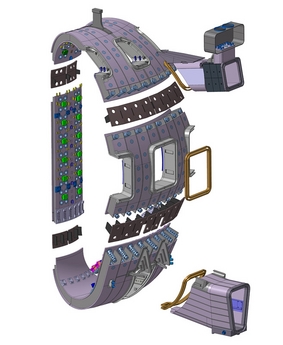The European consortium of AMW (Ansaldo Nucleare S.p.A, Mangiarotti S.p.A and Walter Tosto S.p.A) has won a EUR 300 million contract for the supply of seven sectors of the ITER vacuum vessel.

The contract, expected to run for six years, is the biggest single work package of Europe’s contribution to ITER and is the largest component of the ITER device. The complexity of the vacuum vessel, its size, the amount of welding required and the degree of precision which is needed to build the component, brand this contract as one of the most important and technologically challenging of the ITER project.
The in-wall shielding bolted inside the vessel’s walls will be delivered by India and ports to be welded on the D-shape sectors will be manufactured by Russia and Korea, while the two other sectors of the vacuum vessel will be supplied by Korea.
The ITER vacuum vessel is located inside the cryostat of the ITER device and its basic function is to operate as the chamber that hosts the fusion reaction. Within this torus-shaped vessel, plasma particles collide and release energy without touching any of its walls due to the process of magnetic confinement.
The vacuum vessel is composed of nine sectors made of thick special-grade stainless steel. Each sector is 13 metres high, 6.5 metres wide and 6.3 metres deep. All of the sectors are of the same design. The double-walled sectors that contain the bolted-on shielded plates enclose a pressured void space that attenuates the thermonuclear flux to prevent overheating of the superconducting coils.
Each sector weighs approximately 500 tons. The weight of the entire component, when welded together, will reach 5000 tons, which is equivalent to the weight of the Eiffel Tower.
The ITER vacuum vessel will be twice as big and sixteen times heavier than any previous tokamak. Its double-wall structure is designed to provide a high quality vacuum for the plasma as well as the first confinement barrier for tritium, forming an important part of safety of the ITER device. The vacuum vessel will operate at a temperature close to 100°C and at a nominal water pressure in the void of 11 atmospheres, equivalent to the underwater pressure at 110 metres. The heat of the ITER fusion reactions is removed by the water in the vessel’s cooling loops, while the decay heat may also be removed by natural circulation.
The complex doughnut-shape container will be manufactured and put together in segments, following a significant amount of electron beam welding carried out in the largest vacuum chamber in Europe. The ports and segments have to be joined together with an unprecedented accuracy for this size of vessel. It is estimated that the total amount of welded joints add up to approximately 14 km. Europe’s proven track record in R&D with prototypes in ultrasonic testing inspection technology, weld distortion and analysis, including electron beam welding and its world class facilities in fabrication technology, were essential in undertaking the commitment to provide seven out of the nine sectors of the vacuum vessel.




